Vocal Surveys of the Anuran Population in the Everglades Agricultural Area
Authors
Michelle L. Casler, Wendy M. Bear, Elise V. Pearlstine and Frank J. Mazzotti
Abstract
Distribution and habitat use of anurans in the Everglades Agricultural Area (EAA) have received little attention in the past. Our study will determine what species occur in the EAA. The first six months of a multi-year study of wildlife habitat relations has resulted in the observation of all 13 species of anuran known to occur in adjacent natural areas. However, not all species have been found at each study site in the EAA. A few species occur at only one site, such as Rana grylio and Bufo quercicus. This could be due to the differences in site management and habitat availability, or because these species haven't begun calling at the northern sites.
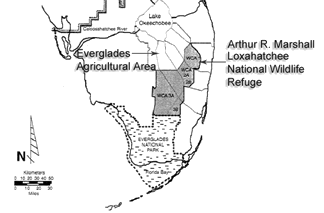
The Everglades Agricultural Area
- The Central and South Florida Flood Control Project established more than 600,000 acres of muck wetlands as the Everglades Agricultural Area (EAA). Agricultural areas in the EAA are connected by a system of canals and ditches, some of which are permanently flooded.
- The fields are often surrounded by brushy vegetation.
- The amount of water in and the amount and type of vegetation around the canals and ditches vary with farm management practices and crop type and stage.
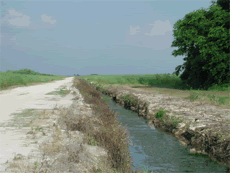 |
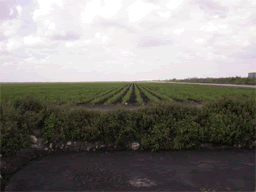 |
| A ditch along a sugarcane field | A young sugar cane field |
Methods
Study sites are located along 5 sugarcane fields with an adjacent canal and/or ditch. Our comparison site includes impoundments 6-8 in the Arthur R. Marshall Loxahatchee National Wildlife Refuge (LNWR). The survey began in October 2002 and will continue through 2004.
- Each study site is broken down into 4-6 points along a road transect with a length of 1-4 miles.
- Surveys begin 15-30 minutes after sunset and last for 10 minutes. Each study site is surveyed at least once per month.
- Approximate number of individuals calling is recorded for each species. Slightly modified from the Wisconsin Frog and Toad Survey protocol.
- The survey includes the road, sugarcane field edge and a canal and/or ditch.
Anuran Species Present
| Species | EAA | LNWR |
| Acris gryllus (Southern Cricket Frog) | X | X |
| Bufo marinusd (Marine Toad) | X | X |
| B. quercicus (Oak Toad) | X | e |
| B. terrestris (Southern Toad) | Xa | X |
| Eleutherodactylus planirostrisd (Greenhouse Frog) | Xa | e |
| Osteopilus sepentrionalisd (Cuban Treefrog) | Xb | Xc |
| Gastrophryne carolinensis (Narrowmouth Toad) | Xa | X |
| Hyla cineria (Green Treefrog) | Xa | X |
| H. squirella (Squirrel Treefrog) | Xa | e |
| Pseudacris nigrita (Southern Chorus Frog) | X | e |
| P. ocularis (Little Grass Frog) | X | X |
| Rana grylio (Pig Frog) | Xa | X |
| R. sphenocephala (Southern Leopard Frog) | Xa | X |
b: Visual encounter, have not heard calling
c: Present around buildings, have not been observed in impoundments during our study
d: Introduced Species in South Florida
e: Should occur in this area (field guides)
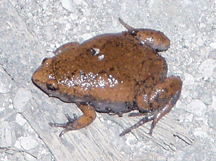 |
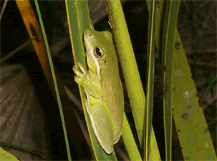 |
| Gastrophryne carolinensis (Narrowmouth Toad) | Hyla cineria (Green Treefrog) |
 |
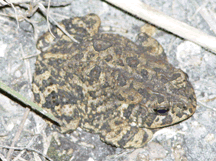 |
| Hyla squirella (Squirrel Treefrog) | Bufo terrestris (Southern Toad) |
Observations
As of March 27th, 2003:
- 10 native and 3 introduced anuran species have been documented in the EAA.
- 6 native and 3 introduced species have been documented during our study in the impoundments at LNWR.
- Rana sphenocephala breeding evidence has been observed with tadpoles being caught in minnow traps in canals and ditches adjacent to the sugarcane fields. A Rana sp. egg mass was observed in a ditch.
- R. grylio has been observed at only one study site in the EAA in large numbers. The canals and ditches are very deep at this site which suggests a more permanent habitat. This may be why they have not been observed at other study sites.
- R. sphenocephala and Bufo terrestris have been heard consistently in moderate to large numbers throughout the survey. Pseudacris nigrita, P. ocularis and Acris gryllus were heard during the first part of the survey in large numbers. Gastrophyrne carolinensis and Hyla squirella have begun to call recently in small numbers coinciding with the rise in temperature. B. quercicus, B. marinus and Eleutherodactylus planirostris have been heard infrequently throughout the survey.
 |
 |
| Rana sphenocephala (Southern Leopard Frog) | Rana grylio (Pig Frog) |
Acknowledgments
Funding for this project was provided by the Everglades Protection District. We would like to thank Charles Wilson, Nick Smith, Charles White and Rudy Wiggins from the US Sugar Corporation; Gerald Powell and Modesto Ulloa from Florida Crystals and Stuart Stein of Wedgeworth Farms for all their help and access to their properties. Thank you to the Arthur R. Marshall Loxahatchee National Wildlife Refuge for their support. We would also like to thank the staff at Belle Glade Research and Education Center for their logistical support.
Citation
Casler, M.L., W.M. Bear, E.V. Pearlstine and F.J. Mazzotti. (2003, April). Vocal Surveys of the Anuran Population in the Everglades Agricultural Area. Poster presented at the Greater Everglades Ecosystem Restoration Conference.
More About This Project
Ecology and Management of Wildlife in the Everglades Agricultural Area




